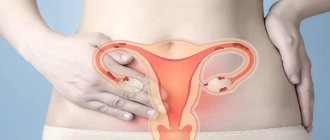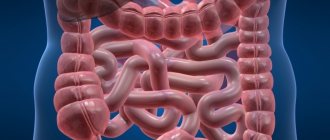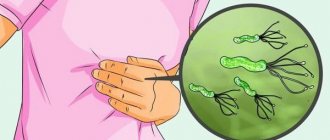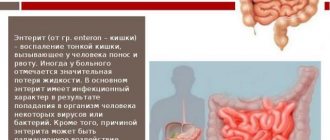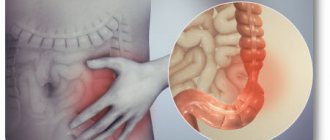Flatulence
– this is an excessive accumulation of gases in the gastrointestinal tract, which can be caused either by increased gas formation or problems with the removal of gases from the body. Gases, as a rule, accumulate either in the stomach or in the right or left bends of the colon.
Gases enter the digestive tract either through the mouth (thus, air is swallowed in small quantities when eating - with each swallow), or are produced during the digestion process. A significant volume of gases is also released when gastric juice is neutralized with soda (some patients with heartburn take soda just to neutralize the acid of the gastric juice, which irritates the gastric mucosa). In small quantities, gases enter the intestines through the bloodstream. Gases are eliminated mainly through the rectum. The volume of gases released in a healthy person varies quite widely. Flatulence is diagnosed when a person experiences discomfort due to an increased amount of gas in the stomach or intestines.
What is bloating
Bloating or flatulence is a syndrome caused by the accumulation of excess gases in the gastrointestinal tract.
Bloating can occur both with excessive formation of gases in the digestive organs and with their insufficient removal. Gas retention is more common in the afternoon, when the digestive system is at its most active. Discomfort may go away after visiting the toilet, but sometimes even the act of defecation does not help - gas continues to accumulate and periodically exits through the anus with various unpleasant odors and loud sounds.
Flatulence is not a separate disease; this condition is manifested by a variety of symptoms, and its occurrence can be influenced by many factors.
Periodic bloating is familiar to absolutely everyone; it is usually associated with eating food that causes increased gas formation, and goes away quite quickly. But constant discomfort and pain in the abdomen indicate the presence of pathology. Very often, bloating is associated with a significant accumulation of feces in the large intestine, excess fat in the abdominal area, and fluid retention in the body. The effectiveness of further treatment depends on the correct identification of the causes of bloating.
Symptoms
Bloating is difficult to confuse with something else. Fermentation of gases is felt in the intestine, a fairly loud rumbling is heard from there, and discomfort arises. All this is accompanied by a feeling of fullness. It should be noted right away that bloating can be very painful. For example, if during constipation gases accumulate in the intestines and stool becomes compacted, they cause stretching of the walls and pain that goes away after defecation.
If there is a large amount of gas, accompanied by abnormal stool, the patient may experience nausea, an unpleasant taste in the mouth, belching, and loss of appetite. But even if flatulence does not cause pain or other symptoms, but is simply accompanied by a loud rumbling, it creates a lot of inconvenience for a person.
It is necessary to urgently consult a specialist if flatulence is accompanied by the following phenomena:
- blood in stool;
- severe sharp pain in any part of the abdomen;
- temperature increase;
- nausea and vomiting.
With prolonged constipation, accompanied by bloating, symptoms of general intoxication of the body may be observed: headache and dizziness, general weakness, irritability, shortness of breath.
When the level of toxins in the body increases, the liver and pancreas begin to work harder, which can lead to the development of dysfunction of these organs.
Causes of bloating
The human intestine produces gas every day, but most of it, about 70%, we absorb through air during meals. Every time we swallow food, 2-3 ml of air enters the stomach with it.
Normally, about 200 ml of gas is constantly present in the intestines of a healthy adult, and the total circulation per day is 20 or more liters. During the same time, from 200 ml to 2 liters of gas are released through the rectum.
The stomach already contains a certain amount of carbon dioxide, a product released during the reaction of hydrochloric acid with foods containing alkalis. Carbon dioxide is also formed in the duodenum when the components of pancreatic juice react with hydrochloric acid coming from the stomach.
Gases in the intestines are formed from several sources:
- gas released during fermentation and rotting of food;
- products of metabolic activity of bacteria formed during the fermentation process;
- gas coming from the circulatory system.
The air supplied with food combines with the gases in the digestive organs, forming foam from small bubbles. These bubbles are covered with slippery mucus, which allows gas to move freely towards the anus during peristalsis.
Organic substances that are not absorbed in the small intestine enter the large intestine. Their composition determines the smell of gas. The unpleasant odor of gases and feces is associated with the formation of hydrogen sulfide and ammonia during the breakdown of proteins. If the products of protein metabolism predominate over other components, the smell of rotting food appears. Plant fibers, cellulose and complex carbohydrates form a large volume of gas, which is dominated by odorless carbon dioxide.
The composition of the gas and its quantity in various segments of the digestive system are determined by the balance between the processes of formation and elimination. Bloating occurs when more gas accumulates in the intestines than the body can eliminate.
Causes of bloating of a physiological nature
All causes of bloating are divided into two large groups: periodic functional disorders that occur in healthy people under the influence of certain factors, and manifestations of various diseases of the digestive system. Common causes of bloating not associated with systemic diseases include:
- Improper eating behavior. Lack of diet, too much food eaten at one time, overeating at night, sedentary lifestyle, constant snacking on unhealthy foods.
- Switching to unusual food products, for example, when traveling to a country with specific culinary traditions. Bloating can also occur when switching to an unbalanced diet in order to lose weight. The cause of the painful condition is a lack of pancreatic enzymes necessary for digesting unfamiliar foods.
- Frequent consumption of foods that stimulate excessive gas formation, for example, kvass and black bread, which begin the fermentation process when they enter the intestines.
- Air travel. The so-called high-altitude flatulence is associated with the expansion of gases and an increase in their pressure on the digestive organs due to a decrease in atmospheric pressure at high altitudes.
- Hormonal changes during the menstrual cycle and pregnancy.
All these reasons do not imply pathologies of internal organs. They are periodic in nature and disappear after the elimination of the factors that caused the discomfort.
Flatulence is common in old age due to inevitable changes in intestinal physiology. Over time, atrophy of the intestinal muscle wall occurs and a decrease in the functionality of digestive juices. As a result, gases and undigested foods are retained in the intestinal lumen, causing flatulence.
Swallowing air
Flatulence caused by swallowing excess air while eating is called aerophagia.
Air swallowed while eating and drinking makes up more than half of the composition of intestinal gas. Swallowing air is associated with:
- quick food on the go,
- talking while eating,
- insufficient chewing and swallowing large pieces,
- smoking while eating,
- drinking carbonated drinks,
- drinking drinks through a straw.
A large volume of air enters the stomach when chewing gum constantly.
After eating in a hurry, part of the swallowed air comes out with belching, but the other part enters the gastrointestinal tract.
Another cause of aerophagia is poorly fitting dentures. A lot of air enters the stomach and with increased salivation, which occurs during neuroses and stress or as a result of certain diseases of the digestive system, for example, pancreatitis or stomach ulcers.
Diseases that cause bloating and gas
Almost all acute or chronic diseases of the digestive system can cause bloating, as they disrupt the processes of digestion and absorption of food and impair intestinal motility.
Most often, flatulence is one of the symptoms:
- inflammation due to colitis, gastritis, enteritis;
- irritable bowel syndrome;
- inflammation of the pancreas - pancreatitis;
- inflammation of the gallbladder and biliary tract - cholecystitis;
- tumors of the stomach and intestines of any etiology, adhesions, the presence of intestinal parasites (worms), etc.;
- acute appendicitis;
- poisoning causing intestinal motility disorders;
- lactose intolerance;
- gluten intolerance - a group of proteins found in cereals;
- neuroses and other diseases of the central nervous system.
An enlarged abdomen is not always associated with excess gas in the intestines. A big belly also appears with obesity. A person may feel quite satisfactory, but we must not forget that excess fat in the abdominal area disrupts the rate of metabolic processes and is a risk factor for the development of hypertension, diabetes and other serious pathologies.
Bloating almost always accompanies another functional disorder of the digestive system - irritable bowel syndrome. With this pathology, gastrointestinal diseases are not detected, and intestinal motility is impaired due to problems of a nervous or humoral nature.
The main symptom of irritable bowel disease is frequent abdominal pain and bowel movements. The stool can be either liquid or too hard, causing constipation. Flatulence accompanies both forms of the disorder. Gases in irritable bowel syndrome are formed due to changes in intestinal microflora and slower motility due to problems with reflex regulation.
A lack of digestive enzymes can occur due to inflammation of the pancreas. As a result, it is not the fermented lump that enters the large intestine, but unprocessed food. Under the influence of bacteria in the colon, food begins to decompose and ferment, producing a significant amount of gas.
A disease not related to the gastrointestinal tract, but causing bloating - ascites. This pathology is characterized by the accumulation of a large amount of fluid in the abdominal cavity. Ascites can be a symptom of severe infection, cirrhosis of the liver, heart and vascular problems, and portal vein thrombosis. This condition requires immediate medical attention.
Flatulence can also be an indirect sign of uterine fibroids, fibroids and ectopic pregnancy. Increasing in size, the uterus begins to squeeze the rectum, preventing the normal release of gases.
Lactose intolerance
Lactase deficiency is another common cause of bloating.
The essence of the pathology is the absence or insufficient activity of the lactase enzyme, whose task is to break down lactose (milk sugar) into glucose and galactose. Milk sugar, unlike glucose and galactose, does not have the ability to be absorbed into the blood and enters unchanged into the large intestine. There, bacteria break it down, and its disposal takes place with the release of a large volume of gas. The test for determining lactase deficiency using exhaled air analysis is based on the features of this process. Pathology is indicated by a high concentration of hydrogen in it. Another symptom of the disease is loose stools with foam and a characteristic sour odor due to increased secretion of water under the influence of undigested lactose.
Lactase deficiency occurs only when drinking whole milk. There is much less milk sugar in kefir, yogurt and other fermented milk products, and there is none at all in cheese and cottage cheese.
Representatives of some peoples at the genetic level cannot tolerate milk sugar, for example, the adult population of Africa. The gene for lactose tolerance is not formed among peoples who have been engaged in crop production rather than agriculture for a long time - the Japanese, Chinese and some other representatives of Asian countries.
Lactase deficiency is sometimes diagnosed in weak premature babies, but these cases are quite rare. Before transferring a newborn to lactose-free formulas, it is necessary to undergo a thorough examination. The situation becomes much more dangerous if the baby is intolerant to casein - the main milk protein, which is found in absolutely all dairy products, including cheese, cottage cheese and all fermented milk products. In this case, the child can be fed only with plant-based milk (Fig. 1), for example, soy milk, and introduced vegetable complementary foods and gluten-free cereals.
Figure 1. Almond and other plant milks do not contain lactose or the milk protein casein. Source: unsplash.com
Every third pregnant woman experiences bloating in the second or third trimester. Increased gas formation is accompanied by frequent belching, heartburn and problems with bowel movements. This may be due to the following factors:
- enlargement of the uterus and its pressure on the intestines;
- slower peristalsis due to hormonal changes;
- increased load on the liver and pancreas and insufficient production of digestive enzymes.
What foods cause bloating in adults?
Flatulence is caused by a large number of foods; this list is largely individual. Some people do not tolerate exotic fruits and unfamiliar cuisine well, while others experience bloating from foods traditional to our latitudes or combinations thereof. But most provoking foods are well known (Fig. 2); they are present in each group:
- Bread and pastries. Gas formation begins after eating products made from yeast dough, since yeast is a fungus that causes the fermentation process. Fresh white bread and baked goods are especially active in causing flatulence. Black bread also begins to actively ferment under the influence of gastric juice, which is why it is used in the production of kvass.
- Milk causes bloating, but fermented milk products, on the contrary, normalize the balance of intestinal microflora.
- Vegetables are the largest group of foods that cause bloating. Fermentation in the intestines is caused by all types of cabbage, especially white cabbage; legumes, especially beans and peas, remain undigested in the intestines for a long time and cause rapid proliferation of bacteria; fresh herbs, cucumbers, all types of radishes, tomatoes, potatoes.
- Fruits. Gas formation when eating fruits is associated with their high sugar content, which stimulates the fermentation process. A particularly active process is caused by grapes, pears, peaches and other juicy sweet fruits.
Other products worth noting are eggs, pork and lamb, and mushrooms. Bloating is caused by large amounts of slowly digested protein and coarse plant fibers. Active fermentation is also provoked by fast carbohydrates.
To prevent your favorite foods from causing flatulence, you can change the cooking method. For example, stewed cabbage does not stimulate gas formation. Cucumbers can be poured with vegetable oil, and legumes can be pre-soaked in water for several hours.
Neutral foods can also cause flatulence if consumed regularly. For example, rice and fish do not activate fermentation, but if you eat only sushi and rolls, constipation will begin very quickly, and with them the process of rotting with increased release of gases.
Figure 2. Foods that cause bloating. Source: MedPortal
Who is most likely to experience bloating?
Despite the fact that bloating in itself is not a disease and can periodically appear in completely healthy people, there are risk groups in which this condition appears very often:
- Overweight people - excess body weight increases the load on all body systems, including the digestive organs. In addition, excess weight usually appears in people with poor eating habits, who prefer fatty and sweet foods in excessive quantities.
- Smokers. Swallowing air occurs not only when smoking regular cigarettes, but also when using electronic gadgets and hookahs.
- Pregnant women due to an increase in the size of the uterus.
- People with chronic diseases of the digestive system, even during remission.
- People suffering from chronic bronchitis and pulmonary diseases. Problems with the bronchi and lungs can also provoke flatulence, since difficulty breathing is one of the reasons for swallowing air while eating.
20-30% of people suffer from bloating from time to time. This is a very common syndrome.
Types of flatulence
This clinical symptom is classified based on the causes that cause it:
- nutritional - associated with an incorrectly composed diet - abuse of fruits and vegetables, brown bread, soda and beer, as well as their incorrect combination with each other;
- dynamic - caused by a violation of the speed of intestinal contraction and slow digestion of food, most often occurs after surgical interventions on the digestive or genitourinary organs;
- digestive - its cause is disturbances in the digestive process (for example, the same hypolactasia and celiac disease);
- psychogenic - associated with mental disorders, including stress or shock;
- dysbiotic - develops due to changes in intestinal microflora, often occurs with gastritis, pancreatitis, cholelithiasis, etc.;
- high altitude - rarely diagnosed in patients, as it is associated with climbing to heights (for example, in the mountains). In this case, the cause of bloating is a decrease in atmospheric pressure.
Where does bloating occur?
Bloating occurs in different parts of the digestive tract.
In the stomach
The stomach always contains a certain amount of air that enters it during meals. The natural mechanism for getting rid of excess air is belching; the remaining volume enters the small intestine.
The stomach contains mainly nitrogen and oxygen - gases contained in the atmosphere and have no odor. An unpleasant odor occurs when gases pass through the small and large intestines.
In the small intestine
In the small intestine, gas bubbles combine with liquid digested food and are absorbed through its mucous membrane.
In the duodenum (the initial part of the small intestine), the reaction of hydrochloric acid with alkali produces carbon dioxide. Under normal conditions, most of the carbon dioxide is absorbed into the blood, and the rest passes further into the large intestine. When carbon dioxide is produced in excess, it is retained in the small intestine, causing bloating.
In the large intestine
Feces accumulate in the large intestine, and gases are not absorbed into the blood. They can only come out through the rectum. Depending on the volume of gas accumulated in the colon, it is released at different frequencies.
Gases affect the functioning of the large intestine in different ways. Thus, an excessive amount of methane in the gas composition leads to constipation, because methane impedes the movement of feces through the rectum. An increased concentration of hydrogen negatively affects motility, but activates movement in the lower parts of the colon.
When there are problems with digestion and undigested food enters the large intestine, the compounds indole and skatole are formed. When they combine with hydrogen sulfide, they acquire a sharp, unpleasant odor.
Diagnostics
In case of persistent flatulence, accompanied by pain of various types and not corrected by diet, you should consult a gastroenterologist or therapist. To find out the reasons, he will draw up a diagnostic action plan. It is possible that you will need to consult a neurologist, infectious disease specialist or oncologist.
At the first stage, a physical examination of the patient helps to obtain valuable information that will suggest the presence of a particular pathology. The patient's history and complaints, auscultation, percussion, and external examination of the abdomen with palpation are collected.
- Inspection. The contours of the abdomen during a visual examination will help determine the cause and nature of flatulence - general or local. For example, if the anterior wall of the abdomen is stretched in the shape of a dome, folds from intestinal loops are visible, then there is a high probability of intestinal obstruction. Noticeable wave-like contractions running from left to right, together with thickening in the epigastric region, suggest mechanical blockage of the gastric sphincter. Redness (erythema) of the palms is a characteristic sign of latent cirrhosis of the liver.
- Auscultation. Bowel obstruction is indicated by whistling noises or sloshing sounds made by accumulated fluid and/or gases. Bowel sounds may be increased (before the obstruction), weakened or completely absent.
- Percussion. When tapping the abdominal wall, a pronounced tympanic sound is heard. The accumulation of fluid in the abdominal cavity is manifested by a dull, fluctuating sound in the flanks of the abdomen. When the body position of the subject changes, the nature of the sound changes.
- Palpation. When gases accumulate in the small intestine, the tense wall of the peritoneum and individual intestinal loops are palpated. You can often feel the movement of gases under your fingers. Sometimes palpation helps to identify the presence of a tumor in the abdominal cavity.
The second stage consists of laboratory and instrumental diagnostics.
Laboratory research:
- Stool lipidogram. Prescribed for suspected neoplasms, other diseases of the pancreas, enteritis, etc. Helps identify disorders of lipid breakdown and absorption.
- General blood analysis. Leukocytosis, an increase in ESR are characteristic of inflammatory processes in the digestive tract, a decrease in hemoglobin, and erythrocytopenia are characteristic of anemia.
- Coprogram. It will help identify fermentopathy, digestive disorders, the presence of helminths, and lamblia.
- Stool culture for dysbacteriosis. To determine the ratio of beneficial, opportunistic and pathogenic bacteria.
- Feces for pancreatic elastase-1. Necessary for studying the condition of the pancreas, which produces this proteolytic enzyme involved in the breakdown of elastin.
- Feces for carbohydrates. To identify pancreatic pathology and inflammatory bowel diseases.
- Biochemical blood test. An increase in bilirubin is observed in hepatitis, amylase in pancreatitis, hypoalbuminemia in nonspecific ulcerative colitis.
Instrumental studies:
- Sigmoidoscopy with visual examination of the rectal mucosa.
- Colonoscopy involves examining the colon using a special probe inserted through the anus.
- X-ray of the intestine with contrast. Studying the passage of barium spreading through the small intestine helps to detect obstructions, diverticula, ulcerations and other intestinal pathologies.
- Irrigoscopy is an X-ray examination of the large intestine into which contrast is injected.
- Ultrasound of internal organs. To assess the condition of organs, detect a possible inflammatory process or tumor formations.
- Ultrasonography of the intestines - ultrasound examination of the intestines. Prescribed to identify tumors and free fluid.
Symptoms of bloating
Excess gas in the digestive system is manifested by general discomfort and some unpleasant symptoms:
- pain and heaviness in different parts of the abdomen or throughout its entire area;
- loud sounds in the stomach, a feeling of constant movement in it;
- release of gas with an unpleasant odor, accompanied by loud sounds.
Sometimes there are complaints of frequent belching with an unpleasant aftertaste, heartburn, indigestion, sleep problems, and emotional instability.
Subjective sensations depend on the specific area of the digestive tract in which gases accumulate. If the delay occurs in the area of the splenic flexure, then the complaints are associated with pain in the left hypochondrium, radiating to the heart, and general bloating. Accumulation in the area under the liver is manifested by pain in the right hypochondrium and a feeling of fullness in the stomach.
Flatulence of the small intestine is characterized by general bloating of the abdomen, and of the large intestine - on the sides.
How to relieve pain from colic in infants
Many young mothers are interested in how to get rid of flatulence and bloating in infants. Children who have this problem begin to scream loudly and kick their legs. Experts advise placing the newborn on a hard surface, tummy down, for 2-4 minutes before feeding. After feeding, you need to hold him in an upright position for 10-15 minutes.
You also need to stroke your tummy in a clockwise circular motion. Regular massage will help relieve pain and spasms. If the child cries a lot, then you need to put a warm diaper on his stomach.
Special gymnastics helps to get rid of colic. You need to press the baby's legs to the tummy. So the gas workers will leave on their own. You can bathe your child in a warm bath with the addition of a decoction of herbs. To prepare the product you will need 3 tbsp. l. chamomile and 0.5 liters of boiling water.
What to do if you have bloating
You can alleviate the condition of bloating by taking certain medications, but taking them without consulting a doctor, relying only on advertising, is very dangerous. If you have abdominal pain, you can take antispasmodics, but it is best to give up junk food for a while and lie down quietly.
When should you go to the doctor?
Check with your doctor if bloating is accompanied by any of the following symptoms:
- severe or prolonged abdominal pain;
- blood in the stool or dark, tarry stool;
- heat;
- diarrhea;
- worsening heartburn;
- vomit;
- asymmetrical abdominal enlargement;
- unexplained weight loss.
If the condition is not acute and does not allow you to leave the house, you should call an ambulance. Bloating may be a sign of acute appendicitis or intestinal obstruction, these conditions require urgent medical attention.
Signs that bloating is caused by a serious problem
Sometimes, based on symptoms, you can suspect a possible cause of bloating:
- Pain and bloating after eating foods made from rye, wheat or barley may indicate celiac disease, a disease associated with gluten intolerance.
- Bloating followed by constipation or diarrhea may mean a person is suffering from irritable bowel syndrome.
- Pain in the right lower abdomen may indicate appendicitis.
- Bloating after eating certain foods can be a sign of a food allergy.
- Painful bloating along with a feeling of nausea may be associated with cholelithiasis.
- In women, bloating and menstrual irregularities may be symptoms of ovarian cancer.
- Pain and bloating when the stomach is empty may indicate ulcers.
Why is there constant bloating?
If abdominal discomfort persists for a long time, then this is a serious reason to contact a therapist and gastroenterologist. Constant bloating is an alarming symptom, indicating the presence of pathology of the digestive system. Particular concern should be caused by the fact of malaise against the background of normalization of nutrition and the abandonment of bad eating habits.
In diseases of the digestive system, bloating is accompanied by a set of other symptoms: severe pain, weakness, nausea, heartburn, diarrhea or constipation.
Treatment for bloating
There is no single treatment regimen for bloating, as it depends on why the condition occurs.
If bloating bothers you very often, you need to consult a gastroenterologist and undergo a comprehensive examination. Treatment is determined by the presence of the underlying disease.
Medicines for bloating and intestines
Any medications are taken only in consultation with a gastroenterologist.
The treatment package includes:
- defoamers - to destroy gas bubbles and facilitate the release of gas to the outside;
- activated carbon and other enterosorbents for collecting toxic bacterial waste;
- prokinetics - to stimulate peristalsis;
- preparations with enzymes to improve digestion;
- probiotics - live bacteria to normalize microflora;
- antispasmodics - to relieve pain.
For constipation, take laxatives, but we should not forget that frequent use of such drugs negatively affects intestinal motor function.
Diet
We cannot talk about any special diet for bloating, since this condition is not a disease. But if attacks occur regularly, then you should adhere to some recommendations for nutrition:
- You need to eat several times a day in small portions, avoid overeating;
- last meal - no less than 4 hours before bedtime;
- limit hard-to-digest foods in your diet - legumes, cabbage, sweet fruits;
- do not drink carbonated drinks, including beer;
- gradually introduce foods rich in fiber into the diet;
- consume fermented milk products, they contain bacteria that are beneficial for the stomach - probiotics;
- exclude fried foods;
- increase the amount of protein in your diet.
Switching to proper balanced nutrition normalizes the functioning of the digestive system and helps to avoid attacks of flatulence.
Treatment of bloating with folk remedies
Traditional medicine offers many recipes to relieve bloating, but they must be used with caution. Any plant is a potential allergen, and failure to comply with the proportions can lead to dire consequences. Before using alternative medicine, you should consult your doctor.
Among the folk remedies with a carminative effect are:
- fennel infusion - 2.5 g of seeds per glass of water;
- mint - boil 10 g of mint leaves in a glass of water for several minutes, let it brew and strain, drink no more than three cups a day;
- anise - boil 2 star anise in a glass of water, cool and drink twice a day.
Chamomile infusion helps with bloating (Fig. 3). In emergency cases, if you have severe heartburn, you can drink a glass of water with a teaspoon of soda.
Figure 3. Plants that help relieve bloating. Source: MedPortal
Folk remedies
Folk remedies will also help with abdominal swelling:
- Parsley decoction – 20g. pour a glass of water, steam for half an hour, strain, drink a tablespoon at a time. up to 4-5 r.
- Dill water – 1 tbsp. Pour a glass of boiling water over the dried seeds, leave for a couple of hours, drink a quarter glass up to 2-3 r.
- Wormwood decoction – 1 tsp. pour a glass of boiling water, leave for half an hour, drink 1 tbsp. three times a day.
A good remedy that reduces gas formation in the intestines is a decoction of pumpkin seeds, tea with chamomile, St. John's wort or sage, a decoction of bird cherry fruits, leaves of coltsfoot or plantain. In order not to provoke unwanted complications, be sure to consult with your doctor before using traditional recipes.
Prevention
Normalizing your diet and healthy lifestyle will help you avoid attacks of flatulence (Fig. 4).
Basic principles of prevention:
- eat often, but in small portions;
- pay attention to physical activity;
- monitor your weight;
- give up carbonated drinks;
- do not chew gum or eat on the go;
- drink more plain clean water;
- include fermented milk products with prebiotics in your diet;
- Keep a food diary to find out which foods cause bloating.
Figure 4. Prevention of flatulence.
Products responsible for increased gas formation
In order for the day to start well, and your heart to be calm, so that you don’t have to swallow dill seeds again, you should familiarize yourself with the list of dangerous products that cause flatulence with vomiting and girdle pain.
People are accustomed to the feeling of a swollen belly from the inside as a reward for drinking milk. But the list of foods to be removed from the diet is much longer. Moreover, many are surprised that their digestion can be affected by apples and other seemingly useful gifts from the garden.
In the first place are recipes with starch-containing elements. They provoke flatulence, confusing women who want to become pregnant but receive a negative test. Among expectant mothers, it is tacitly believed that an increase in gases after conception, and then added drowsiness, indicate the onset of an interesting situation.
In fact, frequent bowel movements, as if you have taken a laxative, exceeding the norm for gas separation several times, indicates that you have eaten in exorbitant quantities:
- pasta;
- potatoes;
- rice;
- corn.
Some people feel nauseous from barley and legumes. But the leaders of an excess of starch, which “give” pressing pain, including a return to the back, are fresh bread and yeast baked goods. Drinking chamomile, or, even worse, urine as urine therapy, are bad decisions. To avoid such a sad outcome, you need to avoid adding such foods to your diet for a week. This way, girls’ large intestines won’t have to cope with high blood pressure, trying to urgently process excess undigested starch using bacteria.
Fiber stands apart. Not everyone understands what this component means, believing that during fasting it is what saves you from fainting from hunger. The list of culprits looks like this:
- raw vegetables;
- fruits;
- berries.
They are not always possible in case of cancer, immediately after Caesarean section due to the difficult movement of coarse fibers through the intestines. The first sign of an organ clogged with fiber includes nagging pain, and some complain of irradiation into the legs.
An attack can be caused not only by porridge, soda taken for heartburn, prolonged exposure to beets, and inflammation of the gastrointestinal tract. Fermented milk products also act as catalysts for long-term distension from the inside, the exact cause of which only a doctor can determine.
Moreover, any representative of the category is capable of causing a real seizure:
- kefir;
- fermented baked milk;
- milk;
- curdled milk;
- cheese.
It is not for nothing that with an ulcer there are also temporary prohibitions on a number of them, as with cirrhosis with individual intolerance.
Experts advise that to eliminate unpleasant symptoms, especially in the first time after childbirth, during embryo transfer, during menstruation, PMS, in the middle of the cycle, drink milk drinks that have been left for a couple of days. Replace fresh cottage cheese with grainy cottage cheese.
Affects the health, and then the tests of a teenager, are the wrong combinations. All signs of alleged poisoning will be evident if you mix dairy products with porridge, baked goods, and cookies. There’s no talk of cucumbers with milk, because everyone knows what such a dangerous combination means, guaranteeing when walking and just standing not just a tingling sensation, but a stinging, foul-smelling gas that no conspiracy can handle.
Periodic deterioration due to protein consumption is considered separately. A real fire in the epigastrium, possible dizziness is guaranteed by an excessive amount of:
- meat;
- fish;
- broth.
Despite the stereotype about the benefits of this, the body is not always able to digest such complex compounds. Eating them every day triggers a rotting mechanism that does not please you with its smell, making your breath worse than after smoking or garlic. Culinary experiments end with a call for an ambulance in the evening.
In medicine, there are cases when flatulence is a side effect of treatment for an illness, or a consequence of the course of the disease. This happens with oncology, fibroids, abnormal acidity, during breastfeeding, if you consume a lot of butter, prunes, beer, dried apricots. Even expensive candles and special gymnastics will not help here.
